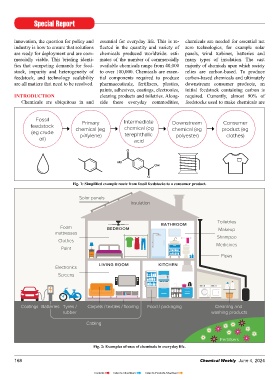Page 168 - CW E-Magazine (4-6-2024)
P. 168
INTRODUCTION
Introduction
Chemicals are ubiquitous in and essential
to make chemicals are from fossil sources
for everyday life. This is reflected in the
– oil, natural gas and coal. Feedstocks are
quantity and variety of chemicals produced
transformed, often at high temperature and
worldwide: estimates of the number of
commercially available chemicals range from
pressure, into the key ‘primary chemicals’ used
. Chemicals are
40,000 to over 100,000
to service the chemical industry.
1,2,3
essential components required to produce
pharmaceuticals, fertilisers, plastics, paints,
In this report, primary chemicals are defined as
ethene (C H ), propene (C H ), butadiene (C H ),
adhesives, coatings, electronics, cleaning
2
6
4
3
products and toiletries. Alongside these
benzene (C H ), toluene (C H CH ), mixed
6
6
6
3
5
xylenes ((CH ) C H ), and methanol (CH OH).
everyday commodities, chemicals are
6
3 2
4
3
needed for essential net zero technologies, Currently, almost 90% of feedstocks used 4 4 6
See Section 3 for further information. These
for example solar panels, wind turbines, primary chemicals are transformed by a wide
batteries and many types of insulation. range of processes and chemical reactions into
Special Report intermediates, speciality and fine chemicals
The vast majority of chemicals upon which used to make consumer products. See Figure 1
for a simplified example of the route from fossil
society relies are carbon-based. To produce
innovation, the question for policy and essential for everyday life. This is re- chemicals are needed for essential net
feedstocks to consumer products. See Figure
carbon-based chemicals and ultimately
industry is how to ensure that solutions flected in the quantity and variety of zero technologies, for example solar
are ready for deployment and are com- chemicals produced worldwide: esti- panels, wind turbines, batteries and
downstream consumer products, an initial
2 for examples of uses of chemicals found in
mercially viable. This briefing identi- mates of the number of commercially many types of insulation. The vast
common consumer products.
feedstock containing carbon is required.
fies that competing demands for feed- available chemicals range from 40,000 majority of chemicals upon which society
INTRODUCTION
stock, impurity and heterogeneity of to over 100,000. Chemicals are essen- relies are carbon-based. To produce
feedstock, and technology scalability tial components required to produce carbon-based chemicals and ultimately
FIGURE 1
are all matters that need to be resolved. pharmaceuticals, fertilisers, plastics, downstream consumer products, an
paints, adhesives, coatings, electronics, initial feedstock containing carbon is
Simplified example route from fossil feedstocks to a consumer product.
InTRoducTIon cleaning products and toiletries. Along- required. Currently, almost 90% of
Chemicals are ubiquitous in and side these everyday commodities, feedstocks used to make chemicals are
Fossil
FIGURE 2 Primary Intermediate Downstream Consumer
feedstock chemical (eg chemical (eg chemical (eg product (eg
(eg crude
Examples uses of chemicals in everyday life. terephthalic polyester) clothes)
p-Xylene)
oil)
acid
O
HO
OH
O
Fig. 1: Simplified example route from fossil feedstocks to a consumer product.
Solar panels
Insulation
1 World Health Organization. Guidance on chemicals and health. See https://www.who.int/tools/compendium-on-health-
and-environment/chemicals#:~:text=More%20than%20160%20million%20chemicals,of%20chemicals%20in%20
commerce%20globally (accessed 19 February 2024). BATHROOM Toiletries
Foam BEDROOM
Makeup
2 UN Environment Programme. Chemical. See https://www.unep.org/beatpollution/forms-pollution/chemical
mattresses
Shampoo
3 European Commission. Transforming EU chemicals regulation to better protect human health and the environment.
Clothes
See https://joint-research-centre.ec.europa.eu/jrc-news-and-updates/transforming-eu-chemicals-regulation-better-
Medicines
Paint
protect-human-health-and-environment-2023-12-11_en (accessed 19 February 2024).
Pipes
4 Renewable Carbon Initiative. 2023. RCI carbon flows report – Compilation of supply and demand of fossil and
renewable carbon on a global and European level. See https://renewable-carbon.eu/publications/product/the-
LIVING ROOM
KITCHEN
Electronics
renewable-carbon-initiatives-carbon-flows-report-pdf/ (accessed 19 February 2024).
Screens
6 CATALYSING CHANGE: DEFOSSILISING THE CHEMICAL INDUSTRY – POLICY BRIEFING
Coatings Batteries Tyres / Carpets / textiles / flooring Food / packaging Cleaning and
rubber washing products
Cabling
Fertilisers
Fig. 2: Examples of uses of chemicals in everyday life.
168 Chemical Weekly June 4, 2024
Contents Index to Advertisers Index to Products Advertised
CATALYSING CHANGE: DEFOSSILISING THE CHEMICAL INDUSTRY – POLICY BRIEFING 7

